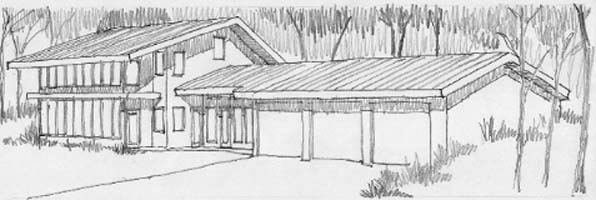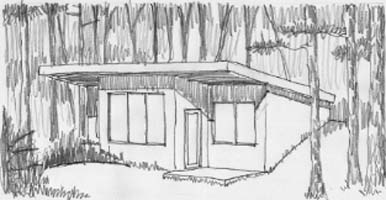Mountain House Plans by Richard C. MacCrea
Email Richard C. MacCrea (828) 837-5787
I enjoy designing homes for people, but I have always wanted to be free to experiment with all of my own ideas.
My clients might like some of them, but no one has been brave enough to try them all.
For many years I have wanted to be free to design something that sets a good example artisticly, environmentally, and practically.
The Mountain Home Show made this possible.
Along with other local companies, I have the opportunity to experiment
with these ideas in a home that others can see either on line, or in person.
The Mountain Model Home
The Mountain Model Cabin
ARTISTICLY: Both the model home and the model cabin have sleek, modern lines that flow perfectly with the property.
These homes are quite small, but have been designed to feel large and open.
This has been done with careful planning of windows, ceilings, and materials,
all designed to open up each area without eliminating privacy.
The use of materials will draw the eye beyond the perimeter of each area to look at the rest of the home and outside.
We are using natural materials like wood cut from the trees on the property with hand rubbed oil finish,
lime plaster walls pigmented with ochre, stained and polished concrete floors, built in furniture,
storage recessed into walls and under furniture, open kitchen cabinetry.
All of the materials and furniture will have similar natural coloring to blend together.
This will make the bright artwork "pop out".
Much of the lighting will be hidden out of view to avoid glare and give the home a warm glow.
ENVIRONMENTALLY: Our home will be passive solar.
This means that during the winter the sun will come in through glass and heat the air inside.
My home will feature a long, shallow, two story solar glass room.
It is carefully designed for the winter sun to quickly heat the air inside this area.
When the doors between the solar glass room and the house are opened,
the force of rising hot air will carry the warmth through every room.
At night when the greenhouse is cold, the doors and windows can be closed, and the free heat will stay inside.
By building with much more insulation, this heat will stay in the house much longer.
The concrete floor will absorb a lot of heat. This is called thermal mass.
At night this heat will radiate back into the house.
I have also planned for summer cooling by natural convection.
Windows can be opened on the shaded north side to let in cool air.
At the peak of the cathedral ceiling, on both ends, other windows can be opened to let the hottest air flow out.
Earth berms around three sides of the home will also keep the home comfortable.
I have carefully chosen materials that are environmentally "green".
Polished concrete floors are very durable.
I won't need to replace them in ten years.
They do not harbor mold and dust mites like carpet.
They do not need adhesives nor do they offgas like vinyl.
We also eliminated a lot of harmful chemicals from these homes by using home made lime wall plaster instead of paint.
Using lumber cut from our own trees saves a lot of energy and pollution from the transportation of materials.
Hand-rubbed oil finishes are much less toxic than the polyurethanes and laquers used by cabinet makers.
We have also carefully chosen materials that reduce the chance of mold growth.
PRACTICALLY: Many of the environmentally "green" ideas save a lot of cost, both in construction and utilities.
At this time I do not have an accounting of the cost savings,
but I know we will save a lot of money on heating and cooling.
We have also saved over $15,000 in construction costs by using our own lumber and having polished concrete floors.
By careful planning, the size of these homes has been greatly reduced,
saving as much as $75,000 in construction costs, and further reducing utility and maintenance costs.
I saved $20,000 in the master bathroom.
Most master baths are designed to provide an escape from the family.
I don't like that philosophy. I believe a home should encourage a family to be together.
While it is beautiful, this bathroom is not a retreat.
Instead of the expensive features and excessive square footage typical bathrooms have,
ours features sleek lines and an efficient plan.
The entire floor slopes to the shower, allowing me to eliminate the divisive shower enclosure.
Sinks are hung on the wall to use much less space and costs far less than standard cabinetry.
This design is also more accessible for someone in a wheel chair.
Bathroom storage is recessed between the studs of the walls,
which is much more practical than having to reach into the cabinet under the sink.
By reducing the size of the master bedroom, I saved $12,000.
To keep the open feeling I want, I designed built in furniture.
The bed has drawers below.
The night stands are built togther into one headboard unit that stretches across the entire wall
to provide lots of drawer and shelf space.
Instead of a wall between the bedroom and the living room, I have designed a built in storage unit.
Some of the shelving faces the bedroom and some faces the living room.
This design provides for practical storage and better sound separation between these rooms.
Windows and glass doors are strategicly placed to open the master bedroom
to the beautiful view in the solar greenhouse.
The Living Room has been designed as a relaxation, entertainment, conversation area.
There is comfortable seating for up to eleven on a built in couch.
Under the seating is storage space.
I designed built in shelving convenient for the electronics entertainment equipment above the couch.
The television is across the room in view of the "L" couch,
next to a place for a large instrument like a piano or organ.
Accessible cable troughs allow easy installation of other equipment and built in speakers.
Because this room is designed for music and television entertainment,
it does not need lots of light or an outside view.
A large metal spiral staircase provides a visual separation from the kitchen area without blocking it off.
The kitchen is designed to be extemely efficient.
Most kitchens have lots of poorly planned cabinetry that gets filled with stuff that no one can find.
By designing the cabinetry to fit the exact storage needs of the family,
everything is more organized, more easily found.
And everything is closer together, making the kitchen more convenient.
For the island I am using a refinished 60" diameter maple butcher block table top.
The dining table will be attached to one side of this island, doubling as eating area and kitchen work surface.
In stead of a pantry, I have planned a canning kitchen.
This separate room has its own stainless steel restaurant sink with plenty of work surface.
This area is not heated to allow for aging of wine and better storage of food.
Surrounded on three sides by dirt, the concrete walls will keep the canning kitchen cool all year.
Seldom used kitchen equipment can also be conveniently stored in this room.
Upstairs bedrooms are for the children.
They have built in furniture, access to the upper level of the solar greenhouse,
and share a loft that overlooks the living area.
By bringing the bathroom sinks outside the bathroom into the loft,
two people can be using the sinks, while one is using the bath or toilet.
Adjacent to the house entry is a seperate office entrance.
This work area can be entered from the house or the covered entry.
The office has its own bathroom which can also be used as a powder room for guests.
This office is fully functional for someone who works full time at home.
Full separation from the house is possible.
Plenty of glass to the south brings in warm winter sunshine,
while also allowing full view of clients driving up.
The garage is fully separated from the house, to keep out exhaust fumes.
A fire wall preotects the home and reduces insurance costs.
With earth bermed on the north wall, and openings to the south,
the garage will be more comfortable for winter projects.
Would you like to see this project under construction?
How to Contact The Mountain Home Show
Appreciation......
This web site contains information obtained from various sources.
The Mountain Home Show is not liable for the accuracy of this information.
Please contact the source of this information with your questions.


Come to the next Mountain Home Show, and you will get an invitation to our open house.
For more informaiton, click on the link to "Detailed information about the home show."
If you are interested in building, you may also be able to make an appointment to visit.
Click on "Email Richard" to make an appointment.
Or perhaps you would like to observe the construction of this home on line.
Click on "Construction Diary."
You are welcome to visit often as we continually update it.
How to Contact Richard C. MacCrea
 My Facebook Page
My Facebook Page
(Design news and ideas)
Email Me
(Opens an email window)
800.738.8781 P.O. Box 446, Murphy, North Carolina 28906
Other Pages on this Web Site
 The Mountain Home Show, Home Page and Site Map
The Mountain Home Show, Home Page and Site Map
(How to find what you're looking for)
The Next Mountain Home Show Program
(For guests and exhibitors)
How to Get in The Mountain Home Show
(For exhibitors)
Articles
(About designing, building and remodeling a mountain home)
The Mountain Model Home
(A home that experiments with extreme energy efficiency)
The Mountain Model Cabin
(A cabin that experiments with small size and energy efficiency)
Construction Diary
(The joys and frustrations of building these two model homes)
Home Designing and Planning
(How to get plans for building or remodeling your home)
 Email Us
Email Us
(Opens an email window)
Like our Facebook Page
(Join our Mountain Home Show Community for news and contacts)
The Mountain Home Show, P.O. Box 446, Murphy, North Carolina 28906-0446
The Mountain Home Show owes its success to the businesses that participate in the show.
They arrange such wonderful exhibits.
It is obvious that they take great pride in their work and our show.